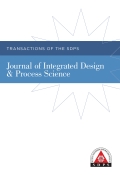Authors: Gonsalves, Tad | Itoh, Kiyoshi
Article Type:
Research Article
Abstract:
Much research has been done on Design Rationale (DR) in software development. DR consists of the decisions made during the design process and the reasons behind them. It is useful for revising, maintaining, documenting, evaluating, and learning the design. In collaboration, rational methods act as catalysts in clarifying issues and their related trade-offs for the involved participants. The three main issues in DR are the capture, representation and use of DR. However, each of these issues
…is rather difficult to pursue in practice mostly because of the overhead they create in the design process. In this paper, we discuss the extension of design rationale (DR) to performance design rationale (PDR) for the development of collaborative systems. The Performance Design Rationale Framework (PDRF) addresses the issues of capture, representation and use, and presents an integrated solution. In collaborative systems, near-optimum performance under the given constraints is a requirement. However, performance design is at best taken for granted, or a patch-work solution is worked out when operational problems are discovered in the deployed system. At the planning and design level, the designers hope and expect that the system will function as per the specifications after its implementation. In other words, the designer's knowledge about the system's performance is not explicit; it is only implicit. PDRF aims at capturing this tacit knowledge and representing it explicitly so that it can be used effectively. PDRF consists of three phases – (1) system modelling, (2) performance evaluation, and (3) performance improvement. It is implemented as an integrated environment with each stage seamlessly flowing into the next stage. Real-life collaborative engineering systems are too complex and too messy to allow a neat mathematical formulation. As an alternative strategy, we adopt a descriptive modelling technique known as Multi-Context Map (Map). Since collaborative systems are discrete-event in nature, performance evaluation is carried on by means of a discrete-event simulator. Finally, the performance improvement or parameter-tuning is accomplished by the application of Qualitative Reasoning (QR). The qualitative rules in the performance improvement expert system are the representation of the domain experts' heuristics or rationale for performance design. Especially through the utilization of PDRF in the development of collaborative systems, the design engineers are utilizing the performance design rationale that is embedded in the PDRF.
Show more
Keywords: design rationale, collaborative systems, performance evaluation, performance improvement, performance design rationale
Citation: Journal of Integrated Design & Process Science,
vol. 11, no. 1, pp. 61-74, 2007
Price: EUR 27.50





